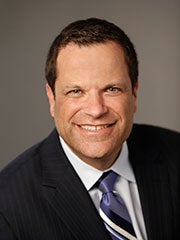The future of the Affordable Care Act
Last month, Congress took the first step toward repeal of the health insurance law, the Affordable Care Act, and now lawmakers are crafting alternatives to replace the ACA. USC experts, from medicine to health care policy, weigh in.
Contact: Emily Gersema at (213) 740-0252 or gersema@usc.edu
____________________________________________________
 California system is a model for expanded coverage
California system is a model for expanded coverage
“The ACA tried to do too much while still leaving 15 million Americans uninsured. Further, the Congressional Budget Office recently projected a 10-year taxpayer bill for the subsidies alone at $866 billion. This is clearly unsustainable and requires a new approach that makes sure all Americans get critical health care when they need it without bankrupting themselves or the government.
“For a model, Congress should examine what happened in California. Here is real success: Medicaid expansion, a state-run exchange, and a group of health insurers committed to expanding coverage.”
Dana Goldman recently wrote these remarks in an op-ed co-authored with a member of the USC Board of Trustees and founding chairman and CEO of Wellpoint, Leonard D. Schaeffer, for The Sacramento Bee. Goldman holds the Leonard D. Schaeffer Chair, directs the USC Schaeffer Center and is a distinguished professor at the USC School of Pharmacy and the USC Price School.
Contact: (213) 821-7948 or dpgoldma@healthpolicy.usc.edu
____________________________________________________
 Hospitals would brace for impact
Hospitals would brace for impact
“While no one knows the consequences of ACA replacement with certainty, we understand from the draft House reconciliation bill that the funding mechanisms — notably taxes, mandates, Medicaid expansion and subsidies — are likely to change by 2019, and that many insurance reforms may remain in place. We anticipate that once the changes are implemented, there will be an impact on patients and hospitals. Patient access and delivery of care are areas we’re examining closely for potential impacts in a protracted replacement scenario.”
As CEO, Tom Jackiewicz leads the strategic vision for Keck Hospital of USC, USC Norris Comprehensive Cancer Hospital, USC Verdugo Hills Hospital, and more than 40 ambulatory clinics that comprise Keck Medicine of USC. Jackiewicz also serves on the boards of the California Hospital Association, the Berkeley Forum and the Dr. Foster Global Comparators comprised of 50 international hospital systems.
Contact: Meg Aldrich, Keck Medicine of USC Marketing and Communications, at (323) 442-3941 or Meg.Aldrich@med.usc.edu
____________________________________________________
 Current proposals may fail sicker patients
Current proposals may fail sicker patients
“Many of the current proposals include, at a minimum, some type of continuous coverage provision that allows people with chronic health conditions who have continuously maintained coverage to buy health insurance at standard rates. For example, Paul Ryan’s ‘A Better Way’ proposal and Secretary Tom Price’s ‘Empowering Patients First Act’ would each prohibit insurers from charging sicker patients more than standard premiums in the individual market as long as they have maintained continuous coverage since before becoming sick.
“Such provisions are important to keep patients from seeing their health insurance premiums sky-rocket after becoming sick, which would defeat the purpose of insurance in the first place. However, these provisions also require that insurers sell policies to these patients at premiums that they know will not cover their expected health care spending, generating losses for the insurance company. On its own, this would create a situation where insurers have a strong financial incentive to avoid enrolling these sicker patients.”
Erin Trish, an assistant research professor at the USC Schaeffer Center and USC Price School, recently wrote this analysis for the Evidence Base blog.
Contact: (213) 821-6178 or etrish@healthpolicy.usc.edu
____________________________________________________
 Repealing ACA tax increases would drive deficits
Repealing ACA tax increases would drive deficits
“The effect on the individual marketplace isn’t the only consequence of a repeal before replacing. Less discussed are the additional challenges created by the tax cuts that would be enacted if Congress models its ACA repeal on the legislation considered last year through the budget reconciliation process — a process that seems increasingly likely. These tax cuts would make it much more difficult to achieve a sustainable replacement plan that provides meaningful coverage without increasing deficits.
“If the goal is truly to replace the Affordable Care Act and still cover a similar number of people, as President Donald Trump and some Republican Congressional leaders have indicated, lawmakers should not repeal the ACA tax increases until a replacement plan is enacted.”
Paul Ginsburg recently wrote these comments with co-author Loren Adler in a blog post for the Brookings Institution. Ginsburg holds the Leonard D. Schaeffer Chair in Health Policy Studies at the Brookings Institution, director of public policy for the USC Schaeffer Center on Health Policy and Economics, and he is a professor for the USC Price School of Public Policy.
Contact: (202) 797-6268 or pginsbur@usc.edu
____________________________________________________
 Repeal would lead to further privatization
Repeal would lead to further privatization
“If repealed, the ACA is very likely to be replaced with a more privatized system. However, the private market has underlying problems. Few policymakers are considering how to protect the poor and vulnerable in a market-driven system.
“It is possible to achieve fairness and efficiency. A strong, vibrant marketplace with prudent government can provide us with both.”
Darius Lakdawalla holds the Quintiles Chair in Pharmaceutical Development and Regulatory Innovation with joint appointments at the USC School of Pharmacy, the Price School of Public Policy, and the USC Schaeffer Center.
Contact: (213) 740-6012 or dlakdawa@usc.edu
# # #
